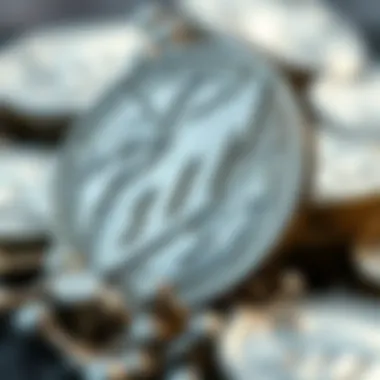Understanding Silver Metal ETFs: A Comprehensive Guide


Intro
Investing in silver through exchange-traded funds (ETFs) is becoming a more appealing option for individuals looking to diversify their portfolios. Silver, with its dual role as both a precious metal and an industrial commodity, continues to draw interest from savvy investors. However, many potential buyers find the inherent intricacies of ETFs daunting. Thus, it's crucial to break down these elements while navigating the sometimes murky waters of this financial product.
Understanding the mechanics behind silver ETFs is vital. These investment vehicles provide exposure to silver without the need for physical ownership, offering a more accessible route for investors. A diversified investment portfolio often includes various assets, and ETFs can be a critical component for managing risks effectively. In this guide, we will explore the various characteristics of silver ETFs, the advantages they provide, and the considerations that any serious investor should keep in mind.
By the end of this article, you'll have a solid grasp on what silver ETFs can bring to your investment strategy, how market dynamics influence silver prices, and strategies that may benefit your approach to investing in silver. Let's delve deeper into the fundamental terms that frame this discussion.
Intro to Silver Metal ETFs
In the labyrinth of investment opportunities, silver metal exchange-traded funds (ETFs) sit at a compelling crossroads. For anyone looking to diversify their portfolio or hedge against economic uncertainties, understanding silver ETFs becomes paramount. These financial instruments provide a unique gateway to invest in silver without the need to juggle physical assets. Furthermore, they come with a multitude of advantages, making them accessible to both seasoned investors and novices alike.
Definition and Overview
Silver ETFs represent a convenient way to invest in silver without the hassle of handling the actual metal. Simply put, a silver ETF is an investment fund that aims to track the price of silver. Investors purchase shares of the ETF, which in turn, holds physical silver or silver-related assets, like stocks of mining companies.
By acquiring shares, investors gain exposure to silver prices, thus allowing them to capitalize on price fluctuations without needing to store or secure the physical metal. This characteristic makes silver ETFs particularly appealing in a fast-paced financial world where simplicity is golden. Additionally, these funds often come with lower fees compared to direct investments in physical silver, enhancing their allure. In essence, silver ETFs provide a seamless bridge between those wanting to invest in silver and the complexities often associated with tangible assets.
Historical Context
The history of silver ETFs is a testament to the evolving nature of investment strategies throughout the years. Initially, silver investments were largely dominated by physical bullion, coins, and mining stocks. However, as various economic factors influenced the market, investors sought more accessible options. The first silver ETF, known as the iShares Silver Trust, was launched in 2006, marking a significant shift in how investors could gain exposure to silver.
This innovation not only democratized access to silver investments but also served to increase overall market liquidity. By tracking the price of silver more effectively, these ETFs became a preferred choice for those looking to benefit from silver price movements without the burdensome logistics of ownership.
One can't overlook how historical events—like major financial crises or significant geopolitical tensions—play a role in the rising demand for silver as a safe-haven asset. In this sense, understanding the context surrounding silver ETFs provides rich insight into their growing importance in modern investment portfolios. As the global economy continues to face challenges, the position of silver ETFs as a reliable investment vehicle is becoming increasingly clear.
Mechanics of Silver ETFs
Understanding the mechanics of Silver ETFs is essential for investors looking to navigate the complexities of this unique asset class. These funds provide exposure to silver without requiring direct ownership of the physical metal. Instead, they enable investors to tap into the silver market through a more instrumented and liquid pathway. The importance of grasping how these funds operate can't be overstated, especially in an era where liquidity and efficiency are paramount. This section will unpack how Silver ETFs work and detail their structure, shedding light on both their advantages and considerations.
How Silver ETFs Work
Silver ETFs function by pooling money from various investors to purchase silver assets, whether in the form of bullion or futures contracts. When an individual invests in a Silver ETF, they are essentially buying shares of that fund, which are directly tied to the performance of silver prices.
- Liquidity: One of the biggest selling points of Silver ETFs is liquidity. Unlike buying bars or coins, investors can buy and sell shares like any stock on an exchange. This ease of trading means you can enter or exit your position without the hassle of dealing with physical storage or associated costs.
- NAV Calculation: The Net Asset Value (NAV) of a Silver ETF is calculated daily and reflects the total value of the fund’s holdings divided by its outstanding shares. Investors should keep an eye on this as it provides insight into the price at which shares are being bought or sold compared to the actual value of the silver held by the fund.
- Tracking Silver Prices: Most Silver ETFs aim to closely track the price of silver through various strategies. These can include holding physical silver in secure vaults, writing options, or investing in silver futures contracts. It's crucial to understand that while these ETFs strive to mimic silver's performance, they may not always do so perfectly due to factors such as fees or management styles.
"Investing in Silver ETFs allows you to participate in the fluctuations of silver prices without the complexities involved in physical ownership."
Structure and Composition
The structure of Silver ETFs is designed to cater to a variety of investor needs, focusing on transparency and operational efficiency. Each fund typically consists of a specific blend of assets that correlate with the price movements of silver.
- Physical Silver vs. Futures: Some ETFs invest primarily in physical silver bullion, storing it in secure facilities. Others utilize futures contracts, which can offer greater leverage but also carry increased risks. Knowing what type of structure an ETF employs is critical for understanding the risks and potential rewards.
- Expense Ratios: Every fund also comes with associated expenses that can affect your returns. These can include management fees, storage fees (for physical silver), and transaction costs. A lower expense ratio generally indicates higher efficiency in fund management, allowing more of your investment to be focused on actual silver exposure.
- Diversity in Holdings: Reputable Silver ETFs may diversify their portfolios by incorporating different forms of silver investments besides straight bullion, such as stocks of silver mining companies. This approach can mitigate risks and provide additional growth opportunities, although it's essential to perform due diligence.
Understanding the mechanics behind Silver ETFs lays the groundwork for making more informed investment decisions. With this knowledge, investors can better assess their options and align their strategies with market movements and personal financial goals.
Advantages of Investing in Silver ETFs
Investing in silver ETFs can be likened to having your cake and eating it too; it presents a unique blend of flexibility, accessibility, and financial opportunity. Silver has often been touted as a safe haven asset, with appeal driven by its physical properties and market behavior. However, as with any investment, understanding the specific advantages of silver ETFs is crucial for investors looking to add them to their portfolios.
Liquidity and Accessibility
Liquidity refers to how easily an asset can be converted into cash without affecting its price. Silver ETFs are typically traded on major stock exchanges, giving investors the ability to buy and sell shares throughout the trading day just like stocks. This instant accessibility is a major plus for many investors. You can enter or exit a position at market prices, which is particularly valuable during periods of market volatility.


- Market Orders: Investors can place market orders accordingly to ensure they trade promptly, taking advantage of desirable price points.
- No Storage Worries: Unlike physical silver, which requires safe storage and security measures, ETFs eliminate those concerns entirely. Your investment is simply a few clicks away on your trading platform, making it a straightforward option for both novice and seasoned investors.
"Liquidity is king; it can help preserve your investment during turbulent times."
Diversification Benefits
Having a diverse investment portfolio isn't just a good idea; it's an insurance policy against market fluctuations. Silver ETFs help achieve this diversification with ease. By investing in a silver ETF, your investment isn't solely tied to the price of silver—but often to a mix of assets related to the silver mining industry. These connections can help dampen risk.
- Exposure to Different Mining Companies: Many silver ETFs hold shares of various mining companies. Instead of putting all your eggs in one basket, your investment benefits from the performance of multiple companies.
- Crisis Hedge: Silver prices often move inversely to other financial assets like stocks or bonds. When the economy stumbles, silver can retain its value, balancing out overall portfolio performance.
Cost Efficiency
When considering any investment, the cost is always a pivotal factor. Silver ETFs can present a more cost-effective way to gain exposure to silver than purchasing physical bullion.
- Lower Premiums: The costs associated with buying physical silver include a premium over the spot price, shipping, and insurance—all of which can add up. In contrast, ETFs typically have lower transaction fees and do not incur these added costs.
- Expense Ratios: When assessing a silver ETF, the expense ratio—annual fees expressed as a percentage of your investment—is crucial. ETFs usually have lower expense ratios compared to mutual funds, making them an attractive option for cost-conscious investors.
Market Factors Influencing Silver Prices
Understanding the myriad of factors that affect silver prices is crucial for investors looking to navigate the dynamic landscape of silver metal ETFs. Numerous elements intermingle, creating a complex environment that can influence price fluctuations profoundly. By recognizing these factors, one can craft investment strategies that respond adeptly to market changes, potentially reaping substantial benefits.
Global Economic Indicators
Global economic indicators act as signposts, providing insight into the health of economies worldwide. These indicators include GDP growth rates, unemployment figures, inflation rates, and consumer confidence. Moreover, changes in interest rates also play a significant role.
For instance, during times of economic downturn or instability, such as the 2008 financial crisis, investors often flock to silver as a safe haven. This rush can push up prices sharply. Conversely, when economies are on an upswing and interest rates are rising, risk appetite increases, and commodities like silver may see diminished demand.
"Silver prices often mirror the health of global economies; when uncertainty looms, the value tends to rise disproportionately."
An example illustrating the connection between economic indicators and silver prices occurred in early 2020. The onset of the COVID-19 pandemic led to widespread uncertainty, resulting in heightened demand for silver. As stock markets faltered and governments implemented drastic measures, the silver market saw a price surge as investors sought out safer alternatives.
Demand and Supply Dynamics
The basic law of supply and demand governs the price of silver, just as it does with any commodity. On one hand, demand for silver arises from various sectors like electronics, solar energy, and jewelry. Notably, the increasing demand for renewable energy technologies such as solar panels has contributed to more robust consumption of silver. As manufacturing ramps up in these sectors, the increased demand can put upward pressure on prices.
On the flip side, supply dynamics are also crucial. Silver mining output, recycling rates, and geopolitical issues affecting mining regions can all impact how much silver is available in the market. For instance, if geopolitical tensions arise in a major silver-producing country, this can lead to supply constraints. In 2018, for example, labor strikes in mines in Mexico – one of the world’s leading silver producers – temporarily reduced supply, which in turn pushed prices higher.
Key Factors Impacting Supply and Demand:
- Industrial uses: Increased demand in tech, photography, and renewable energy sectors.
- Mining production levels: Variability in output can lead to price fluctuations.
- Market speculation: Traders’ expectations about future supply can drive current prices.
- Investment demand: Growth in ETFs can absorb demand and push prices higher.
Geopolitical Events
Geopolitical events can have a substantial influence on silver prices by affecting the overall market sentiment. Political instability, trade wars, tariffs, and other international tensions often instigate movements in commodity markets. Additionally, these events can shape investor behavior as they react to perceived risk or opportunity.
For example, the U.S.-China trade tensions witnessed in 2019 created significant market anxieties. Investors, skittish about the ramifications of prolonged disputes, turned to safe-haven assets like silver, which saw price spikes as a result. Similarly, the recent conflicts in Eastern Europe have had ripple effects, impacting not only energy prices but also the demand outlook for silver as companies reconsider their supply chains.
When the world feels volatile, commodities often become a refuge for investors. In such scenarios, it's not uncommon to see silver's price rise, driven by demand from those seeking stability amidst uncertainty. Understanding these dynamics can help investors anticipate shifts in the silver market based on unfolding events.
Selecting the Right Silver ETF
Choosing the right silver ETF can feel like trying to find a needle in a haystack, especially given the plethora of options available. This crucial step can either pave the way for a rewarding investment experience or lead you down a rabbit hole with lackluster returns. Investors must consider various factors, not just the headline performance figures.
Evaluating Performance Metrics
When assessing silver ETFs, performance metrics are your bread and butter. They offer insights into how the fund has fared over time compared to its peers and the silver market at large. Pay close attention to:


- Total Returns: Look at both short-term and long-term returns. This can show you how the ETF performs in different market conditions.
- Tracking Error: This indicates how closely the ETF's performance aligns with that of silver. A low tracking error means it's doing a good job mimicking silver prices.
- Comparative Indexing: How does the ETF stack up against standard benchmarks like the S&P GSCI Silver Index? A consistent performance above this marker can be encouraging.
Evaluating these metrics gives a clearer picture of the ETF's historical performance and its potential for future gains.
Understanding Expense Ratios
Expense ratios can be as critical as performance metrics, often overlooked but equally important. This figure reflects your cost of doing business with a particular ETF. A higher expense ratio can eat into your profits faster than you might imagine, especially in a traditionally volatile market like silver.
- General Guidance: Ideally, you want to target ETFs with low expense ratios, typically in the range of 0.25% to 0.75%. While a low expense ratio isn't a guarantee of superior performance, it does help ensure that more of your investment is working for you.
- Long-term Impact: Even a modest difference in expense ratios can have significant implications over the long haul. For instance, a 0.1% difference in expense ratios could equal hundreds of dollars over decades, assuming a consistent investment growth rate.
Researching Fund Holdings
The contents of an ETF's portfolio are also telling of its investment strategy and risk profile. Check out what’s inside the fund before diving in:
- Physical Silver vs. Future Contracts: Some ETFs hold physical silver, while others might invest in futures or stocks of mining companies. Each has its own risk profile.
- Concentration: Look at whether the fund is overly concentrated in a few holdings or has a diverse array. Diversification generally helps mitigate risk.
- Activity in the Market: From time to time, a fund may adjust its underlying assets based on market conditions. Keeping an eye on these changes will assist in understanding your investment better.
In summary, selecting a silver ETF involves a multifaceted analysis. By evaluating performance metrics, understanding expense ratios, and researching fund holdings effectively, you can make a more informed choice in this complex and dynamic landscape of silver investments.
Risks Associated with Silver ETFs
Investing often resembles a dance with risk; you might lead, but the partner can take sudden steps. In the realm of silver ETFs, understanding the associated risks is paramount to safeguarding your investment. The allure of silver, historically viewed as a hedge against inflation and currency fluctuations, comes with its share of caveats. This section will delve into the three significant risks—market volatility, counterparty risks, and regulatory changes—that investors should keep under their radar.
Market Volatility
Market volatility can be viewed as the tempest in the investment seas, stirring currents that can sweep even the most seasoned investor off their feet. Silver prices often fluctuate widely due to various factors, such as economic data releases, changes in consumer demand, and geopolitical tensions. These fluctuations can lead to rapid gains or losses, significantly affecting the value of silver ETFs. Investors must realize that during times of crisis or uncertainty, silver can behave unexpectedly, sometimes soaring to new heights or plummeting into the depths.
- Supply Chain Disruptions: Events like strikes in mining regions or trade disputes can halt silver production, causing prices to climb.
- Market Sentiment: Speculative trading can exacerbate swings in silver price, creating a feeding frenzy amid sudden investor sentiment shifts.
"In the world of investing, the toughest lesson is often learned riding the waves of volatility." —Anonymous
Counterparty Risks
Counterparty risk represents the chance that the entity managing the ETF, or a related party, might fail to fulfill their contractual obligations. If an investor places their bets on a silver ETF that engages heavily with intermediaries or has complex structures, it's crucial to assess the reliability of these partners. For instance, if the fund’s custodian—a firm responsible for holding and safeguarding physical silver—defaults or goes into bankruptcy, it can directly impact the ETF's performance.
- Custodial Issues: If a custodian mishandles the physical silver or doesn’t have appropriate insurance, it could lead to significant losses.
- Management Performance: The skill and experience of the fund managers play critical roles in navigating market fluctuations while ensuring that the underlying assets are managed effectively.
Regulatory Changes
Regulatory changes are akin to the shifting sands beneath your feet as they can redefine the playing field overnight. Governments and financial institutions regularly update laws and regulations, impacting how silver ETFs operate and are taxed. Changes in trade policies or import taxes might affect the underlying silver prices, causing ripples in the market. Furthermore, any alterations in rules governing ETFs themselves can introduce new compliance costs or limitations.
- Tax Implications: Depending on jurisdiction, changes in tax policy can affect how profits from silver ETFs are taxed, directly influencing your bottom line.
- Policy Changes: An increase in tariffs on precious metals can impact the cost of silver, subsequently affecting ETF values.
Investors need to stay ahead of these movements, as … it’s crucial to adapt strategies accordingly based on how regulations might impact not only ETF performance but also the broader silver market. Keeping abreast of news on regulatory trends can furnish investors with insights crucial for making well-informed decisions.
In summary, while silver ETFs can be a rewarding investment, recognizing and navigating the associate risks is essential. Awareness of market volatility, counterparty reliability, and regulative landscapes can arm investors with the knowledge they need to thrive amid uncertainty.
Tax Considerations in Silver ETF Investments
When it comes to investing in silver ETFs, understanding the tax implications can be as crucial as knowing the ins and outs of the market itself. For many, the prospect of financial growth is often offset by considerations regarding tax liabilities. Silver ETFs, unlike traditional stocks, involve unique tax treatments that can affect an investor's bottom line. Hence, delving into this topic is essential for any serious investor, accounting professional, or financial advisor.
Understanding Tax Implications
Investing in silver ETFs can produce capital gains, which are taxed differently than stocks. Notably, for U.S. investors, the Internal Revenue Service considers most silver ETFs as collectibles if they hold physical silver. This means any gains realized upon selling the ETF shares are taxed at a maximum rate of 28% — substantially higher than the typical long-term capital gains rate of 15% or 20% that applies to other investment assets.


In some cases, if an investor holds the ETF for over a year before selling, the long-term capital gains tax would still not apply. This treatment can be a real shocker for those who are used to the more favorable rates of other types of investments. Investors need to keep this in mind when calculating potential returns; the tax consequences can eat significantly into profits.
"Understanding the tax implications of your investments is just as important as understanding the market trends. Don’t let unexpected tax burdens derail your investment strategy."
Additionally, some ETFs may utilize strategies that limit tax exposure, such as passing through income or gains that might qualify for different tax treatments. Knowledge of these strategies can play a pivotal role in investment decisions and overall portfolio management.
Reporting Requirements
When it comes time to report gains or losses from silver ETF transactions, clear documentation becomes vital. The "Schedule D" form is typically where you’ll report capital gains and losses. However, specific details on the type of asset sold, including whether it's a collectible, are essential for correct reporting.
Here are a few key points to consider regarding reporting requirements for silver ETFs:
- Ensure accurate transaction records: Keeping track of the purchase and sale price, holding period, and any adjustments is necessary.
- Using a tax professional: Many investors find it beneficial to consult with a tax advisor who understands the nuances of silver ETF taxation.
- Deadlines and forms: Be aware of submission deadlines for relevant tax documents to avoid penalties.
In summary, tax considerations in silver ETF investments cannot be overlooked. Understanding tax implications and adhering to reporting requirements not only aids investors in compliance but also ensures they capitalize on their investments to the fullest. By taking the time to familiarize oneself with these aspects, investors can strategically navigate their portfolios and make decisions that maximize their financial growth.
Future Outlook for Silver ETFs
The future of silver metal ETFs holds significance for investors keen on positioning themselves in this precious metal market. As the global economy evolves, understanding the potential directions and developments of silver ETFs can enable individuals to optimize their investment strategies. Not only do these funds provide exposure to silver prices, but they also reflect broader market trends that may emerge.
Market Projections
Looking ahead, several factors shape the projections for silver ETFs. First off, there is a palpable increase in the adoption of renewable energy technologies, particularly solar power, which uses silver in solar panels. Analysts expect demand for silver to rise as more countries transition to greener energy solutions. This uptick in demand can likely support upward pressure on silver prices, which may positively affect the values of silver ETFs.
Moreover, central banks are embracing more unconventional monetary policies. As inflationary pressures linger, silver, traditionally viewed as a hedge against inflation, might see a surge in interest. Entities like the Federal Reserve are influencing market conditions, creating a backdrop that can propel silver prices upward. Therefore, it’s crucial for investors to keep an eye on these economic indicators, as they could solidify projections for silver ETFs.
- Increased demand from the solar industry
- Central banks' monetary policies
- Inflation concerns influencing investment strategies
"Investing in silver is not just about the metal itself; it's about understanding the clouds gathering on the financial horizon, and silver ETFs open that window."
Emerging Trends
As we look at emerging trends within the silver ETF landscape, a few noteworthy developments come into play. The rise of ESG (Environmental, Social, and Governance) investing is particularly relevant. Investors are increasingly seeking sustainable investment options, and silver plays a crucial role in various sustainable technologies. Silver ETFs are starting to reflect this shift, with some funds incorporating ESG criteria into their investment strategies. This movement not only enhances the appeal of silver ETFs but might also lead to more robust market performance.
With technology advancing, there is also an increase in the accessibility of trading platforms and apps. Retail investors are more empowered than ever to step into the world of silver ETFs, expanding the market's potential participant base. Enhanced education for beginners through online resources and platforms can simplify the complexities of these investments, making silver ETFs an attractive option for a broader audience.
Furthermore, trends in digital assets cannot be ignored. The intersection of cryptocurrencies and precious metals is gaining traction, with some investors viewing silver as a complementary asset in their digital portfolios. As interest in alternatives grows, silver ETFs may adapt by offering innovative features that cater to tech-savvy investors looking for blended investment avenues.
- Incorporation of ESG criteria
- Enhanced accessibility through technology
- Intersection of silver with digital assets
With these insights into the future's horizon, it's evident that investing in silver ETFs is not merely a reactionary move; it's a strategic decision grounded in a thorough understanding of market dynamics and emerging trends.
End
In the realm of investment, understanding the nuances of silver metal ETFs plays a pivotal role for anyone looking to diversify their portfolio. This guide encapsulates the crux of what these financial instruments are, their operational mechanics, and the various dimensions that influence market behavior. For potential investors, grasping these concepts is not just beneficial but essential.
Summation of Key Points
This article has shed light on several critical areas:
- Definition and Mechanics: Silver ETFs are designed to simplify ownership in silver, allowing investors to access this metal's price fluctuations without needing to physically hold the commodity.
- Benefits: They provide liquidity, cost efficiency, and diversification within investment portfolios. These attributes make them appealing when compared to direct silver investments.
- Market Dynamics: Prices are directly influenced by global economic indicators, supply-and-demand mechanics, and geopolitical situations. Investors need to stay informed about these aspects to anticipate market movements accurately.
- Choosing the Right ETF: Evaluating performance metrics, transparent expense ratios, and the underlying holdings are steps that shouldn’t be overlooked. Each of these areas impacts long-term returns, thus necessitating careful consideration.
- Risks: It’s prudent to recognize market volatility, counterparty risk, and possible changes in regulatory frameworks that could affect performance.
Final Thoughts
In summary, while silver ETFs present a compelling avenue for investment, they also come with layers of complexity. Investors should arm themselves with a robust understanding of both the opportunities and risks associated. The silver market tends to be affected by fluctuating global conditions, which often require a nuanced approach. Balancing the desire for wealth addition with the realities of risk management is key.
Investing in silver through ETFs should not be impulsive; instead, it’s about making informed choices that align with broader financial goals. Just as seasoned navigators understand the stars to direct their path, wise investors need to comprehend market signals to steer their financial journey successfully.
"Knowledge is the compass that guides your investment decisions through the fog of unpredictability."
By forming a solid understanding of what silver ETFs entail, investors foster a stronger foundation for their financial future. Armed with this knowledge, they are better prepared to participate in the ever-evolving landscape of financial markets.







